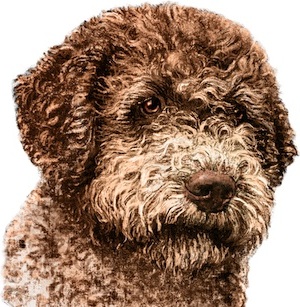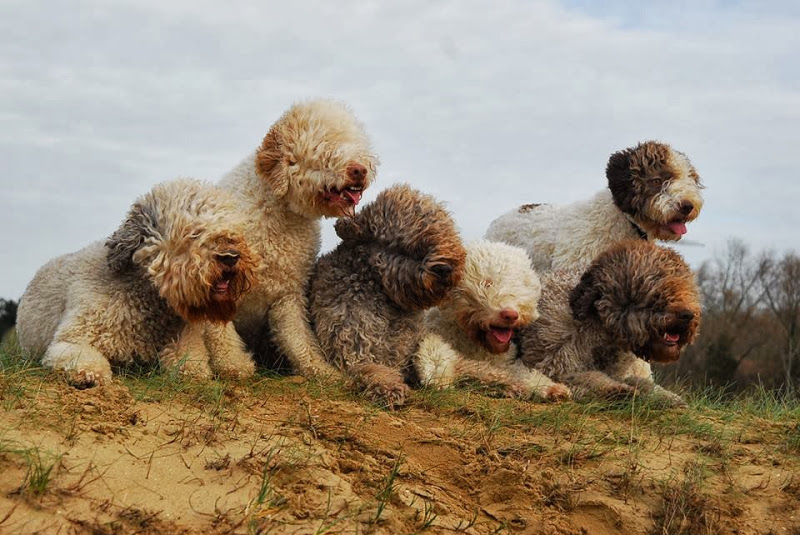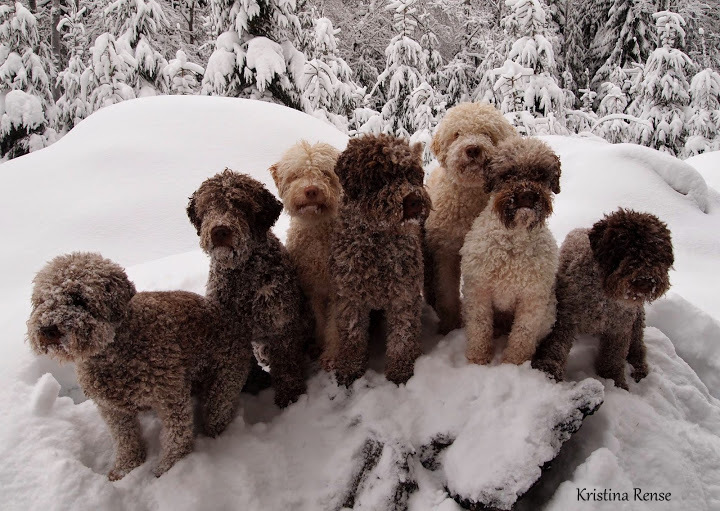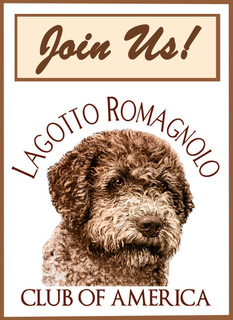|
Official Standard of the Lagotto Romagnolo General Appearance: Small to medium-sized dog, well proportioned, powerfully built, of a rustic appearance, with a dense, curly coat of woolly texture. The dog should give the impression that he has the strength and endurance to work all day in difficult and challenging terrain. Size, Proportion, Substance: Size - Height at the withers: Dogs 17 to19 inches, Bitches 16 to 18 inches. Tolerance of 1⁄2 inch. Disqualification - Dogs under 161⁄2 inches or over 191⁄2 inches. Bitches under 151⁄2 inches or over 181⁄2 inches. Weight - Males 28 to 35 pounds. Females 24 to 31 pounds. Important Proportions - The length of the head is four-tenths of the height at the withers. The dog is nearly as high as long (square). The length of the dog, measured from the sternum to the ischium is nearly the same as the height at the withers. The length of the skull should be slightly more than 50 percent of the total length of the head. The depth of the chest is less than 50 percent (about 44 percent) of the height at the withers. Head: When viewed from above the head is trapezoidal in shape and moderately broad; the upper longitudinal axis of the skull and the muzzle diverge slightly. Cheeks flat. Axis of the skull and the muzzle converging or appearing “dishfaced” is a fault. Viewed from the side, from occiput to stop, the skull should be longer than the muzzle. The skull measured across the area of the zygomatic arches is wide and equal to the area from the stop to the occipital crest, both being slightly more than 50 percent of the total length of the head (56 percent). Frontal sinuses well developed, marked arch of the eyebrows, the occipital crest is not very developed, the stop not too pronounced though the furrow between the eyes is pronounced. The ridge formed by the eye sockets is palpable from the eyebrows to the side of the head. The eyes are large, but never exaggerated, rounded, filling the socket, set fairly apart. The color of the iris ranges from ochre to hazel and dark brown depending on the color of the coat. Close fitting eyelids; eye-rim color will vary with coat color from flesh colored to dark brown. Eyelashes very well developed. The Lagotto’s expression should be alert, keen and lively. Walleye(s), an eye with a whitish iris, a blue eye, are a disqualifying fault. The ears are medium-sized in proportion to the head, triangular with rounded tips; their base is rather wide; they are set just above the zygomatic arches. Hanging at rest or slightly raised when the dog is attentive. The ears when pulled loosely forward across the cheeks towards the nose tip should cover 1⁄4 of the length of the muzzle. Muzzle is measured from eyes to nose tip. On the ears, the hair tends to show looser curls, but remains very wavy. Except where trimmed to the edges there should be no short hair on the ears. The inner part of the auricle is also covered with hair. The muzzle is broad in width, in length a little shorter than the skull (44 to 56 percent ratio). The muzzle is wedge shaped, giving a blunt profile. The nose is large with wide open and mobile nostrils. Median groove strongly pronounced. The bridge of the muzzle has a straight profile, a roman nose is a fault. Viewed in profile, the nose continues on the same level as the muzzle and protrudes very slightly from the front edge of the lips. Color will vary with coat color from flesh colored to dark brown. The nose should be fully pigmented. A de-pigmented nose is a fault. The lips are not too thick; they are rather tight, so that the lower profile of the muzzle is determined by the mandible. They are covered with a long and rather bristly moustache. Color will vary with coat color from flesh colored to dark brown. The flews are tight fitting and dry. Strong underjaw which is relatively large with white and well developed teeth. The mandibular braches of the jaw should be straight. Reverse scissor bite, scissor bite or level bite are all acceptable. Overshot bite and pronounced undershot bite (more than a 1⁄4 inch space between the upper and lower incisors) are both disqualifying faults. Full dentition is preferred. No more than one missing tooth. The missing tooth to be allowed only between P1-P4. Any tooth missing other than a premolar or more than one missing tooth is a disqualification. Neck, Topline and Body: The neck is strong, muscular, lean and oval in shape; well set off from the nape, and slightly arched. In males the perimeter of the neck can reach the double of its length. Short in appearance, it is less than the total length of the head. The topline - well pronounced withers, topline straight from behind the withers to the croup, which is slightly sloping. Body - compact and strong. The length of the dog, measured from the sternum to the ischium is nearly the same as the height. Chest - well developed, reaching down to the Ribs: - well developed, narrow in front; widening from the sixth rib back (behind the shoulders) to the last rib. Underline-long sternal section in form of a straight line; the following tuck-up is only slight. Back-straight, very muscular. Loin - short coupled, very strong, width is equal or slightly exceeds the length. Croup - long, wide, muscular, slightly sloping. Tail - set on slightly below the line of the back; following the natural line of the croup. The length of the tail when hanging at rest should barely reach the hocks. At rest carried scimitar like or straight; when excited it is decidedly raised. When moving the tail is often carried level with the back. When working or excited can be raised higher, also scimitar like, but never curled or straight Forequarters: Shoulder - shoulder blades long (30 percent of the height at withers), well laid back (52 to 55 degrees), muscular, strong and closely attached to the chest, but moving freely. The angle formed between the shoulder blade and the upper arm should be 110 to 115 degrees. Upper Arm - muscular, of thin bone structure, as long as the shoulder blade; its inclination to the horizontal ranges from 58 to 60 degrees. Elbow - tucked firmly against the brisket; covered with thin skin. Parallel to the median sagittal plane (means in line with the spine) of the body as are the upper arms. The tip of the elbow is located on a vertical line lowered from the back end of the scapula to the ground. Forearm - perfectly vertical, long (36 percent of the height at withers), with compact, strong bone of oval cross-section. Carpus (wrist)-viewed from the front in a vertical line with the forearm; fine, robust and mobile; the bone of the carpus markedly protruding. Pasterns - rather less thick and of finer bone compared with the forearm. Seen in profile, slightly sloping (They form an angle of 75 to 80 degrees with the ground). Dewclaws - must be present on the front legs. Missing dewclaws are a disqualifying fault. Forefeet - slightly rounded, compact, with well arched and tight toes having well developed webbing between the toes. Pads are fully pigmented. Nails are strong and curved and may range in color from white to so dark a brown as to appear black. Hindquarters: Angulation - in balance with the forequarters. Legs powerful, upright seen from the rear, well proportioned to the size of the dog and parallel. Upper thigh - long (35 percent of the height at withers), with well defined muscles. The axis of the femur has a distinct inclination of 80 degrees to the horizontal. The coxo-femoral angle ranges from 105 to 110 degrees. The thigh is parallel to the median plane of the body. Stifle-the angle of the stifle ranges from 130 to 135 degrees. Second thigh-slightly longer than the upper thigh (36 percent of the height at withers), well boned and muscled, with marked muscular groove. Its inclination to the horizontal ranges from 50 to 55 degrees. Its direction is parallel to the median plane of body. Hocks (rear pastern) - well let down. Thin, cylindrical, perpendicular to the ground. Hind feet- slightly oval shaped, compact, with toes slightly less arched than those of the forefeet and with well-developed webbing between the toes. Pads are fully pigmented. Nails are strong and somewhat straighter than those of the forefeet and may range in color from white to so dark a brown as to appear black. Dewclaws present on rear feet is a disqualification. Coat: Hair - of woolly texture, never twisted to form thin cords, semi-rough on the surface, with tight, ring shaped curls, with visible undercoat. Curls must be evenly distributed all over the body and tail, except on the head, where the curls are not as tight forming abundant eyebrows, whiskers and beard. Even the cheeks are covered with thick hair. The topcoat and specially the undercoat are water-proof. The clipped coat must not be longer than a maximum of 11⁄2 to 2 inches in a curled state (not brushed out) and it should be uniform with the silhouette of the dog. Only on the head the coat can be longer than 11⁄2 inches, but not so long as to cover the eyes. The edges of the ears should be clipped to the leather, though the surface of the ear flap should show wavy hair. The area around the genitals and anus should be clipped short. The hair should never be clipped so short (except as noted above) that curls and texture of the coat cannot be assessed. The correct clip is un-pretentious and contributes to accentuate the natural, rustic look typical of the breed. The correct coat is never luxurious and shiny. Excessively groomed dogs (sculpted or blown out so that the curl may not be assessed) should be so severely penalized as to eliminate from competition. Disqualification – Corded coat. Skin -thin, close fitting all over the body, without wrinkles. Pigmentation of the skin connecting with mucous membranes and that of pads ranges from light to dark and very dark brown. Color: Off-white solid color, white with brown or orange patches, brown roan, brown (in different shades) with or without white, orange with or without white. Some dogs have a brown to dark brown mask. Tan markings (in different shades) allowed. The colors have a tendency to fade to a more diluted shade as the dog ages, sometimes to such an extent that the brown areas can appear as a silvery/gray roan. All the above colors are equally desirable including faded or diluted colors. Black coat, black patches or black pigmentation are to be disqualified. Gait/Movement: Energetic trot with reach and drive. Lively and balanced. Behavior and Temperament: The Lagotto is tractable, undemanding, keen, affectionate, very attached to his owner and easy to train. He is also a very good companion and an excellent watch-dog. A natural gift for searching and a very good nose has made the breed very efficient in finding truffles. The former hunting instinct has been modified by genetic selection; hence his work is not distracted by the scent of game. The dog should be neither aggressive nor overly shy. Faults: Any departure from the foregoing points should be considered a fault and the seriousness with which the fault should be regarded should be in exact proportion to its degree and its effect upon the health and welfare of the dog and on its ability to perform its traditional work. Disqualifications: Size - Dogs under 161⁄2 inches or over 191⁄2 inches. Bitches under 151⁄2 inches or over 181⁄2 inches. Walleye(s), an eye with a whitish iris, a blue eye. Bite - Overshot bite, pronounced undershot bite (more than a 1⁄4 inch space between the upper and lower incisors). Teeth - Any tooth missing other than a premolar or more than one missing tooth. Dewclaws - Missing on front feet or present on rear feet. Coat - Corded coat. Color - Black coat, black patches or black pigmentation. Approved November 20, 2012 Effective January 1, 2013 |
|
Height at the wither | Defects |






